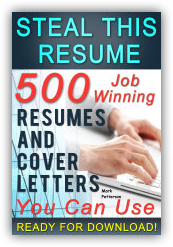Here’s the ugly truth about Resume formats: fancy isn’t better. If you create a fancy Resume on expensive paper it may impress your friends and relatives but employers see right through any sort of window dressing.
Prospective employers want to know certain facts about you. And they want to find these facts quickly. Don’t waste their time. Make it easy for them to give your job-winning Resume a quick glance and then want to dive in deeper.
How? Make your great Resume appear light and airy with plenty of white space and no lengthy chunks of black text.
Keep sentences short and simple. Don’t overdo the adjectives and adverbs. Or the buzzwords. Or the jargon. Keep to the point.
You can be a little more wordy in your cover letter. Remember that prospective employers are not so much interested in your job duties as they are in how well you performed those duties — your accomplishments and achievements.
Two of the best formats to use for your job-winning Resume are the Chronological and the Functional.
The chronological format is simple and basic. Use it for showing a steady and dependable work history.
Here’s an example of a chronological format.
The functional format is more sophisticated and flexible. Use it to emphasize important skill areas and achievements that a prospective employer would value.
Here’s a sample of a functional format.
Did you happen to notice the positioning of your name on each Resume sample? It’s on the upper right corner and there are two good reasons for that.
Reason Number One is that when your great Resume is sitting in a file folder your name will be easily seen by anyone riffling through.
Reason Number Two is more psychological and centuries old. Next time you pick up a newspaper notice where the most important front-page story is: in the upper right hand corner. Two small points, maybe, but I say take the edge wherever you can.
Keep the typeface simple and readable. Times New Roman or Courier New are perfectly acceptable. Generally speaking 12-pt. font is best, but if you need to squeeze in more reduce the font size to 11-pt.
Try and keep margins at 1-inch all around. But if you need to squeeze in more information you can reduce the margins to 0.9 inch or 0.8 inch.
The key is to keep a nice airy look that’s inviting to read.
If a company requires you to submit your great Resume online then read and carefully follow their particular guidelines. Same if you’re applying for a government or academic position.
Some companies require that you fill in ‘point and click’ boxes instead of submitting your entire Resume. Since you’ve already written your great Resume all you need to do is cut and paste the relevant sections.
Length: one page is great. Two pages is also acceptable as long as it’s necessary and not just stretching things out. On rare occasions you might need three pages but if you’re just repeating things or blowing stuff out of proportion you will be judged harshly.
Always remember that formatting is not nearly as important as the wording. And that’s where you need to focus on.
Employers are constantly looking for great employees. They’ve seen millions of different formats and just aren’t impressed with fancy window-dressing. Keep your job-winning Resume simple, easy-to-read and informative.
And always remember to sell yourself on the benefits of hiring you.
Next up: Cover Letters
